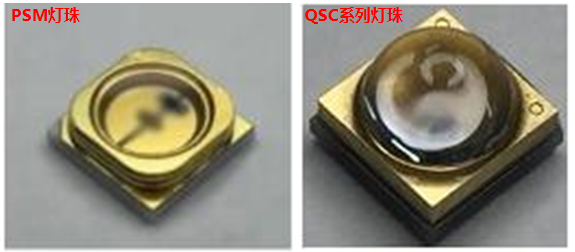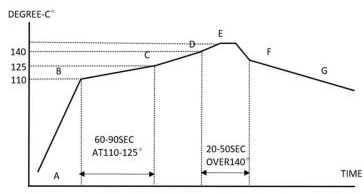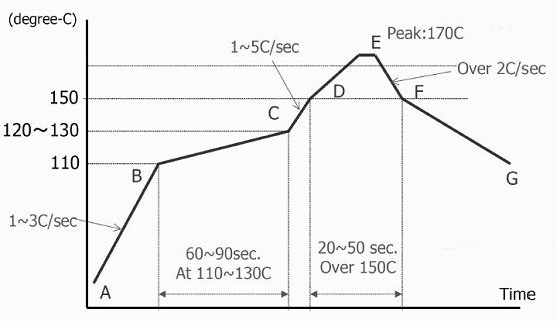Mass production reflow soldering patch
In the typical packaging structure of deep UV uvc-led, the UVC chip may be soldered on the ceramic bracket by solder paste or eutectic welding. The difference of welding temperature between the two packaging processes leads to a big difference in the maximum acceptable reflow temperature of subsequent SMT. At the same time, some special glue filling process is easy to make the chip break away from the pad during the reflow process of high temperature, resulting in false soldering, and finally open the lamp. Therefore, our SMT process should strictly follow the recommended reflux curve (see Section 3 must follow the reflux curve) to avoid high probability of dead lights.
1. Reflow temperature resistance of solder paste and eutectic solder package beads
1.1 solder paste welding:Solder the chip pad to the bracket by solder paste. Compared with the traditional silver glue solid crystal, the thermal resistance and thermal conductivity of the chip are greatly improved, and the heat generated by the chip can be quickly emitted. At the same time, its mechanical properties are significantly enhanced, and the reliability of lamp beads is improved.
1.2 eutectic welding:Two different metals can form alloys in a certain proportion by weight at temperatures far below their respective melting points. Eutectic welding has the advantages of high thermal conductivity, low resistance, fast heat transfer, high reliability and high shear force after bonding. The hole rate of welding face is relatively low, but the equipment cost is high.
At present, the melting point of solder paste used by our company is 217 ℃, and the most commonly used eutectic solder for eutectic welding is gold tin alloy, and its eutectic temperature is 278 ℃. Compared with eutectic process, the solder paste has a higher void rate and a lower interfacial adhesion, so eutectic welding has more advantages in temperature resistance.
2. Introduction of silica gel package / lens package

2.1、The above are the lamp beads mainly supplied by our company at present. There are two packaging processes, one is silicone filling (namely PSM lamp beads), the other is lens packaging (QSC series lamp beads). The PSM lamp beads are filled with UV resistant silica gel directly after the solid crystal is completed, but there is no colloidal filling in the lens package. The lens is directly fixed on the bracket step by UV glue for encapsulation.
2.2、Due to the silica gel filling process, the internal stress of PSM lamp beads inevitably increases due to the shrinkage of thermal barrier under heating conditions, which leads to the stress on the interface between the chip and the bracket increases. In serious cases, the chip and the support pad peel off, resulting in open circuit and dead lamp. Therefore, compared with QSC series lamp beads, PSM lamp beads are more prone to open circuit and dead light when reflow soldering.
3. Be sure to follow the reflux temperature curve

Silicone filled uvc-led lamp beads
Silicone filled uvc-led lamp beadsLow temperature solder paste should be used for reflow soldering. The temperature peak temperature should not be greater than 155 ℃, the temperature peak time should be controlled within 20 seconds, and the reflow time should not be more than 5 minutes. Tin bismuth solder paste is recommended.

Quartz lens package uvc-led lamp beads
Quartz lens package uvc-led lamp beadsLow temperature solder paste should be used for reflow soldering. The temperature peak temperature should not be greater than 170 ℃, the peak time should be controlled at 20 seconds, and the reflow time should not be more than 5 minutes. Tin bismuth solder paste is recommended.
